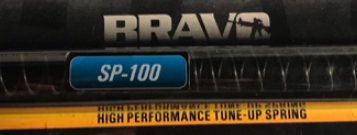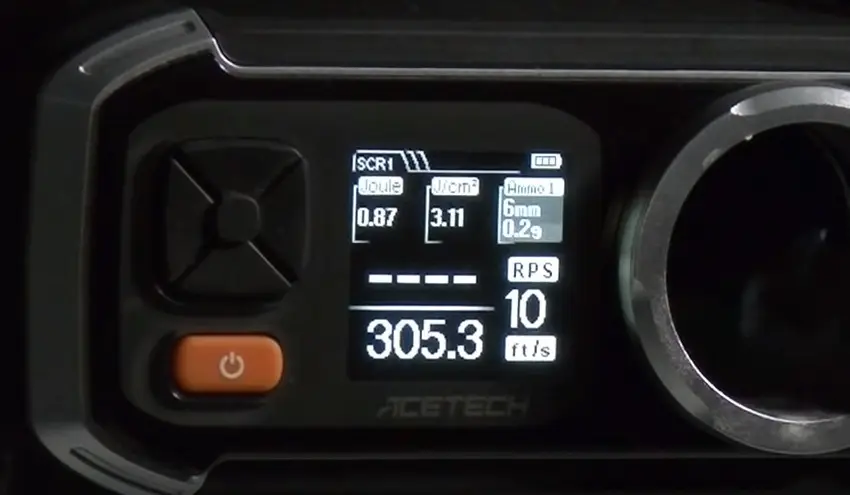Why Lower Your FPS In The First Place?
Whether to squeeze out a little more range or to put some much-needed fear back in your opponents, there are a lot of different reasons to want to increase the velocity of your AEG airsoft gun.
But there are also some good reasons why you might want to lower your FPS.
Most notably, most indoor and CQB airsoft fields and events tend to place fairly strict limits on the power output of airsoft guns they allow in for player safety.
Some fields are more lenient and will simply exact (and enforce) stricter minimum engagement distances and other limitations on guns exceeding a certain velocity.
Anything shooting over 400 FPS will need to fire from 30m away with lighter BBs and only on semi, for example.
Other fields might take a more risk-averse stance and simply blanket ban any airsoft gun chronoing over a certain velocity, 350 or 400 FPS for example.
Therefore, If you want to take your favorite M4 or even your nice new bullpup and have a little at one of these fields, or if an indoor/CQB field is the only game in town, you might need to take things down a notch.
Things To Keep In Mind When Modding For Lower FPS
Before you start working out how you’re going to modify your 450 FPS airsoft rifle to accommodate field limits, there are a few things you’ll want to consider.
Reversible
While you may want to lower your AEG’s power output to slide under any stringent FPS limits that may exist at certain fields, it is also likely that, at some point, you might want to bring your gun’s power back up (outdoor events, for example).
As a result, you might want to avoid doing any permanent internal modifications to your gun, as getting back to 400+FPS may be time consuming and expensive.
Should be field legal
There are ways to reduce FPS in an AEG (or at least get by chrono testing) that certain airsoft fields frown upon or outright ban, due to their ability to be easily reversed by players.
Notably these include trying to slip by a chrono with heavier BBs, tuning down your hop up or using a barrel-mounted velocity reducer.
At this point, most indoor airsoft fields are wise to such tricks and trying to evade their rules can (and probably will) result in being kicked out or even banned.
Shouldn’t have much of an effect on accuracy or consistency
There’s no point in lowering the FPS of your airsoft gun to get by a chrono if what you do to get there makes your AEG erratic or basically useless past a few feet.
It’s important to keep in mind that AEGs are often balanced systems, and that modifying certain parts can have a sometimes dramatic and unintended effect on the performance of other components.
It’s always wise, therefore, to try and start as simply as possible and do your research to avoid solutions that can cause compression issues or other inconsistencies.
Changing Springs
Expanding and contracting with every cycle, in an AEG the strength of its spring is probably one of the biggest contributors to FPS.

All things being equal, the stronger the spring, the faster the gun’s piston will travel and, ultimately, the higher the velocity of the BB in terms of feet per second.
Conversely, and perhaps more importantly for the purposes of this article, the weaker the spring, the lower th eFPS.
Consequently, probably the most reliable way to lower FPS on an AEG airsoft gun (and the least likely to cause you long term headaches) is to simply make the spring weaker.
There are generally two ways airsofters tend to go about this.
Spring Cutting
The first way is to cut their existing spring down.
A trick that sort of developed before airsoft became as popular and before replacement or upgrade springs were as common as they are today, the long and short of it is that a user cuts off coils from a spring and reduces its recoil strength until the desired FPS is achieved.
This generally involves taking a small hacksaw blade or dremel and cutting the spring down a half coil at a time, re-inserting it, testing with a Chrono and recutting as necessary.
The process isn’t really recommended anymore for a few reasons.
The first is that, depending on the spring, it can be a time-intensive and laborious process.
You’ll also have to pay attention, as it can be easy to make the spring too short to be useful.
Secondly, it’s not always about length.
The strength of a spring can also involve the materials used to make it and its relative thickness.
While it is one thing to cut off a couple coils here and there, if you have to start trying to reheat and retemper a spring, things can get complex quite quickly.
Finally, these days properly machined and tested replacement springs are pretty commonly available and, importantly, quite cheap to buy.
Spring Swap
Buying a new spring and swapping it in is by far the more sensible method for reducing FPS.
A brand new spring, fresh from the factory, will generally cost less than $20 and finding one to match a specific (even uncommon) AEG is a snap in the ecommerce age.
Having been unmodified and manufactured to specific and fairly precise standards, a new spring will generally offer more consistent and reliable performance than a cut-down equivalent.
More than that, they’re often not that hard to install.
While it’s true that some models of airsoft guns require users (or their techs) to pop open their gearbox and manually remove/replace the main spring, most newer models tend to include some kind of quick change spring system.
While we’ve discussed quick change systems in more depth before, essentially these are a feature of modern gearboxes that allow users to remove and replace the spring guide as they’d like without having to open the gearbox.
Generally speaking, gearboxes with such systems have a small port at the back that directly accesses the spring guide.
Users simply pop their gun open and unscrew the back of the gearbox and remove the spring guide.
They then swap the spring for a new one and replace the guide.
In some instances, such as with the KWA Ronin series or the Valken ASL AEG in the video below, the spring can be accessed through the buffer tube, so you don’t even have to disassemble your gun to do so.
With such modern quick change systems, popping in a new spring can literally be done in the parking lot of a CQB field if you suddenly find yourself chronoing a little hot.
Finally, and something that’s important to note, buying a new spring instead of modifying your existing one will leave you with the original part intact, meaning you can go back to full power a lot more easily and at your convenience.
Different Springs, Different Outcomes
When it comes to picking up a new spring with the intention of lowering the FPS on your AEG, thanks to the wonders of modern ecommerce, there is an absolute wealth of choice out there.
Those new to airsoft should note that springs come with different power classifications, which are usually printed on their box or described on the product page.
Unfortunately, different manufacturers tend to use different designations for the approximate power that their springs will help deliver, such as M, S and percentages.
One of the more common designations of airsoft springs begins with M (M90, M100, M105, and so on).
Broadly speaking, these relate to the power output in meters per second as measured with a 0.20g BB.
All things being equal, the lower the number, the FPS output, with M85s and M90s generally yielding sub-300 FPS.
Another common designation is Guarder’s SP (SP90, SP100 and so on).
These also relate to power output in meters per second, but are measured with 0.25g BBs.
As a result, they are a little more powerful than their M-equivalents (sometimes up to 40 FPS or more), which is something to keep in mind if you’re aiming to just scrape by a chrono test.
When it comes to translating this into FPS, it’s important to keep in mind that there are a lot of variables at play when it comes to FPS in an AEG, not the least of which is nozzle seals, piston seals, cylinder size, hop up and even the inner barrel bore.
While a manufacturer’s spring designation can give you a good idea of where you’re headed, FPS output can vary wildly between manufacturers or even just between setups.
What is challenging about swapping springs to lower FPS?
Aside from needing to deal with non-quick change systems, one of the main issues with swapping springs that airsofters typically encounter is simply not knowing what kind of spring comes stock with their gun.
A good part of down powering your airsoft gun of choice from a spring swap is predicated on having this information at hand – after all, you can’t pick out a relatively weaker spring if you don’t know where you’re starting from.
Manufacturers aren’t always forthcoming about such details and, honestly, are capable of using a good deal of technical know-how to squeeze a good deal of performance from weaker springs.
What About Airsoft Velocity Reducers?
Velocity reducers are a class of gadgets that, when attached to an airsoft gun, are designed to reduce its FPS output.
There are a couple different types out there, some are installed in a gearbox, while others attach at the barrel.
The ones that fit into a gearbox work by essentially disrupting or breaking airseals, in theory reducing the compression and, thus, power output.
As a whole, aside from sounding less than ideal, these devices aren’t always so easy to install (or uninstall) by non-techs and tend to create rather inconsistent and unreliable performance in the gun they are attached to.
Those that attach to an airsoft gun’s barrel, on the other hand, causes passing BBs to hit a small rubber fin or wiper on their way out, introducing additional friction/impact that can cause a loss of velocity.
Aside from the fact that impeding the BBs progress in this way can cause significant accuracy issues, the little rubber devices inside tend to wear out over time.
More importantly, not every field allows the installation of a barrel velocity reducer, as some players have a bad habit of removing them during a game.
Overall, while these devices do work, they tend to be a bit more of a hassle than simply changing out springs.
What About Modifying Other Internals?
Another way that you can, in theory, reduce FPS output on an AEG is to modify some of its internals.
Generally speaking, we don’t really recommend this for most airsofters, as doing so tends to be a bit more complicated than a spring change, harder to reverse and can have some unexpected consequences to an airsoft gun’s overall performance.
Swapping inner barrels
As we’ve discussed in a previous article, while inner barrel length doesn’t always have a lot to do with accuracy, it can have a significant impact on power.
Swapping an airsoft gun’s inner barrel to a much smaller version (say 150mm or so) can reduce FPS.
That said, assuming you can even find a compatible and adequately compact inner barrel for your gun to really drop FPS, they can involve quite a bit more work to install and (if/when you would like to have more power again) uninstall.
Similarly, unless the cylinder is matched, this can introduce considerable inconsistency into the system and cause erratic performance.
As a result, it’s not usually a go-to FPS-lowering mod.
Short Stroking
Short stroking, or removing teeth from a sector gear to shorten the amount of time the piston requires to cycle, is usually done to increase the rate of fire of a lagging AEG.
As a (usually negative) side effect, it also tends to reduce FPS.
This, of course, isn’t generally considered a first choice of reliably lowering FPS on an AEG as it is simultaneously not all that easy to do for a beginner and is something of a permanent modification.
If you want to go back to having higher FPS, you’ll have to get a new gear.
Bottom Line
Although most airsoft players are more interested in squeezing out more power from their AEG, strict FPS limits at certain fields mean that sometimes airsofters might have to think about lowering their FPS output, as well.
Although this can be accomplished by certain modifications, as well as certain devices and gadgets, the cheapest, easiest and most reliable method of doing so is still by removing and replacing the spring with a weaker one.

Will Martin – Will has been into airsoft and paintball for well over 10 years, and has done it all – from upgrading and fixing gearboxes as a tech to building custom airsoft loadouts for his friends to supporting off those friends as a DM.

Ted Clark– Hailing from Florida, Ted has been an avid airsoft enthusiast since he was in middle school. When he’s not checking out and reviewing airsoft guns, he enjoys picking off his enemies one by one on the field as a sniper.

